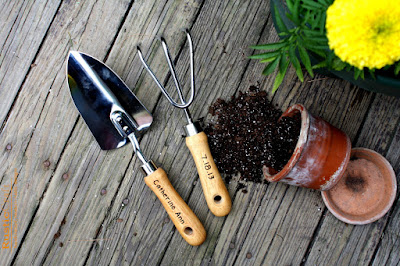Having the right home and garden supply for every aspect of gardening is essential to achieving garden success.
You'll need garden supplies for planning your garden, for getting your
garden going, for maintaining your garden, and of course, for harvesting your garden.
I'll talk about each area of supply you need and give you some ideas about a garden supply company or two as well.
Let's start at the beginning...
 |
| Garden Tools |
Home and Garden Supply Ideas for Planning Your Garden
Before you even get to the point of starting a garden you need to have a plan. Now, for some, this might just be taking the time to think about your goals for the garden and what you like and then getting a general vague idea of what having a garden means to you. In that case, your required garden planning supplies might be nothing more than a few garden catalogs or some
garden magazines that you can leaf through for inspiration.
But others may like their planning to be a bit more formal. If that sounds like you, then you might be interested in looking at some garden planning kits like the ones you can find at Springhill Nurseries , an online garden supply company. They have plans for everything from a 3-season garden to a ring around the tree garden.
Garden Gate Magazine has a website,
GardenPlans.com, where you can download free garden plans. Here are a couple they have:
• Winning Combination—Three free one-page garden bed design plans add color and interest to your garden.
• Cold Frame Plan—Get an early start on the growing season with this easy-to-build cold frame.
You can also get 2 free garden-related screensavers at GardenPlans.com. I don't really like the one, as it is bugs, but the other one is watercolor paintings of flowers.
At Country Living's website (part of iVillage.com), you can get free garden plans based on your garden's size, where you live (your zone), and what season you want your garden to bloom in. Just go to this page to see what I mean.
You can also just do a search on Google to find free garden plans. Just type "free garden plans" or "garden plans" into the search box below:
Home and Garden Supply Ideas for Planting
Once you have your garden planned, you'll be ready for planting. You'll need supplies such as seeds, seedlings, plants, and tools.
If seeds are what you're after in terms of home and garden supply, then you'll want to check out
Gurney's Seed and Nursery Company .
Another great garden supply online seed warehouse is Henry Fields Seed and Nursery Company .
For bulbs, try one of these choices:
• Visit bloomingbulb.com for #1 quality Holland flower bulbs... at wholesale prices!
• Breck's Bulbs,
• Michigan Bulb,
And then, you can find plants and more at Springhill Nurseries .
Supplies for Maintaining Your Garden
Once your seeds or plants are planted in the garden, your work is not over. You still have to keep them healthy and promote their growth. That will take home and garden supplies such as watering cans, hoses, pesticide (or natural alternatives), rakes and hoes, mulch, etc.
Your goal will be to keep your garden beds as weed-free as possible, to keep your garden soil moist and filled with the right nutrients and to keep your flowers, vegetables and other plants growing and vibrant.
Supplies for Harvesting Your Garden
Finally, all your hard work of the past months is paid off on the day you begin to harvest your vegetables! In many cases, harvesting is as easy as using your fingers to pluck succulent tomatoes or green beans from the plants on which they are growing. But in other cases, you'll need special shears or digging tools (for root veggies).
You can find almost any garden supply online at a web-based garden supply company. Here's are a couple of garden supply companies we recommend highly...
When it comes right down to it, picking the right home and garden supply is not rocket science. It's really just a matter of figuring out what you need and then finding a reliable garden supply company to get it from.




